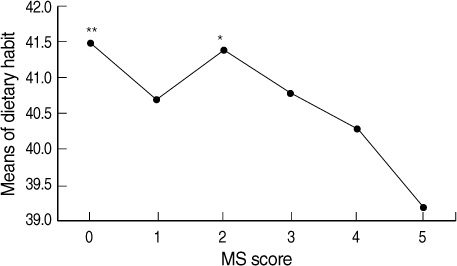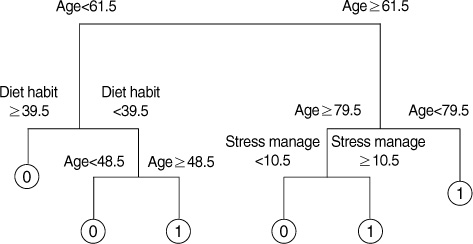Impact of Life Style Characteristics on Prevalence Risk of Metabolic Syndrome
- Affiliations
-
- 1Nursing Policy Research Institute, Yonsei University, Seoul, Korea.
- 2Department of Nursing, Severance Hospital, Seoul, Korea.
- 3University of Illinois at Chicago, IL, USA.
- 4College of Nursing, Yonsei University, Seoul, Korea. narcii@hanmail.net
- KMID: 820236
- DOI: http://doi.org/10.4040/jkan.2009.39.4.594
Abstract
-
PURPOSE: The goal of this study was to evaluate the impact of life style characteristics on the prevalence risk of metabolic syndrome (MS).
METHODS
A total of 581 adults were recruited from a cardiovascular outpatient clinic. A newly developed comprehensive life style evaluation tool for MS patients was used, and patient data related to the MS diagnosis were reviewed from the hospital records.
RESULTS
The overall prevalence of MS was 53.2%, and the mean of MS score was 2.6 for patients at a cardiovascular outpatient clinic (78% of the patients had hypertension). Dietary habits among the life style characteristics had significant influence on the prevalence risk of MS and MS scores. And also interestingly, the classification and regression tree (CART) model suggested that the high prevalence risk groups for MS were older adults (61.5< or =age<79.4), and adults between 48.5 and 61.5 yr of age with bad dietary habits.
CONCLUSION
This study indicates that nurses should focus on dietary habits of patients (especially patients classified as high prevalence risk for MS) for improvement and prevention of MS prevalence risk.
Keyword
MeSH Terms
Figure
Cited by 7 articles
-
Field Application and Evaluation of Health Status Assessment Tool based on Dietary Patterns for Middle-Aged Women
Hye-Jin Lee, Kyung-Hea Lee
Korean J Community Nutr. 2018;23(4):277-288. doi: 10.5720/kjcn.2018.23.4.277.Factors Influencing Metabolic Syndrome among Mental Health Facility Patients with Schizophrenia
Sun-Hye Lee, Sunhee Cho
J Korean Acad Psychiatr Ment Health Nurs. 2016;25(1):1-10. doi: 10.12934/jkpmhn.2016.25.1.1.Factors Influencing Metabolic Syndrome among Mental Health Facility Patients with Schizophrenia
Sun-Hye Lee, Sunhee Cho
J Korean Acad Psychiatr Ment Health Nurs. 2016;25(1):1-10. doi: 10.12934/jkpmhn.2016.25.1.1.The Effects of Lifestyle Factors on Metabolic Syndrome among Korean Adults
Mee Young Im, Young-Ran Lee, Suk Jung Han, Chung-Min Cho
J Korean Acad Community Health Nurs. 2012;23(1):13-21. doi: 10.12799/jkachn.2012.23.1.13.The Effects of Lifestyle Factors on Metabolic Syndrome among Korean Adults
Mee Young Im, Young-Ran Lee, Suk Jung Han, Chung-Min Cho
J Korean Acad Community Health Nurs. 2012;23(1):13-21. doi: 10.12799/jkachn.2012.23.1.13.Influence of Occupational Type and Lifestyle Risk Factors on Prevalence of Metabolic Syndrome among Male Workers: A Retrospective Cohort Study
So Hui Kang, Seon Young Hwang
Korean J Adult Nurs. 2016;28(2):180-190. doi: 10.7469/kjan.2016.28.2.180.Moderating effect of Lifestyle and Type D personality on the Relationship between Metabolic Syndrome and Severity of Coronary Artery Disease
In-Kyoung Noh, Myoung Soo Kim
Korean J Adult Nurs. 2018;30(3):290-300. doi: 10.7475/kjan.2018.30.3.290.
Reference
-
1. American Heart Association Nutrition Committee. Diet and lifestyle recommendations revision 2006: A scientific statement from the American Heart Association Nutrition Committee. Circulation. 2006. 114:82–96.2. Azadbakht L, Mirmiran P, Esmaillzadeh A, Azizi T, Azizi F. Beneficial effect of dietary approaches to stop hypertension eating plan on features of the metabolic syndrome. Diabetes Care. 2005. 28:2823–2831.3. Eckel RH, Barouch WW, Ershow AG. Report of the National Heart, Lung, and Blood Institute-National Institute of Diabetes and Digestive and Kidney Diseases Working Group on the pathophysiology of obesity-associated cardiovascular disease. Circulation. 2002. 105:2923–2928.4. Erdfelder E, Faul F, Buchner A. GPOWER: A general power analysis program. Behavior Research Methods, Instruments, & Computers. 1996. 28:1–11.5. Ford ES. Prevalence of the metabolic syndrome in US populations. Endocrinology and Metabolism Clinics of North America. 2004. 33:333–350.6. Ford ES, Giles WH, Dietz WH. Prevalence of the metabolic syndrome among US adults: Findings from the third national health and nutrition examination survey. Journal of the American Medical Association. 2002. 287:356–359.7. Giugliano D, Ceriello A, Esposito K. The effects of diet on inflammation: Emphasis on the metabolic syndrome. Journal of the American College of Cardiology. 2006. 48:677–685.8. Grundy SM, Cleeman JI, Daniels SR, Donato KA, Eckel RH, Franklin BA. Diagnosis and management of the metabolic syndrome: An American Heart Association/National Heart, Lung, and Blood Institute scientific statement. Circulation. 2005. 12:2735–2752.9. Gupta R, Deedwania PC, Gupta A, Rastogi S, Panwar RB, Kothari K. Prevalence of metabolic syndrome in an Indian urban population. International Journal of Cardiology. 2004. 97:257–261.10. Henriksen EJ. Invited review: Effects of acute exercise and exercise training on insulin resistance. Journal of Applied Physiology. 2002. 93:788–796.11. Hu FB, Li TY, Colditz GA, Willett WC, Manson JE. Television watching and other sedentary behaviors in relation to risk of obesity and type 2 diabetes mellitus in women. Journal of the American Medical Association. 2003. 289:1785–1791.12. Hu G, Jousilahti P, Borodulin K, Barengo NC, Lakka TA, Nissinen A, et al. Occupational, commuting, leisure-time physical activity in relation to coronary heart disease among middle-aged Finnish men and women. Atherosclerosis. 2007. 194:490–497.13. Isomaa B, Almgren P, Tuomi T, Forsén B, Lahti K, Nissén M, et al. Cardiovascular morbidity and mortality associated with the metabolic syndrome. Diabetes Care. 2001. 24:683–689.14. Kahn R, Buse J, Ferranini E, Stern M. The metabolic syndrome: Time for a critical appraisal. Joint statement from the American Diabetes Association and the European Association for the study of Diabetes. Diabetologia. 2005. 48:1684–1699.15. Kang SW. Development of a lifestyle evaluation tool for patients with metabolic syndrome. 2007. Seoul: Yonsei University;Unpublished doctoral dissertation.16. Kim YH, Yang YO. Effects of walking exercise on metabolic syndrome risk factors and body composition in obese middle school girls. Journal of Korean Academy of Nursing. 2005. 35:858–867.17. Lee WY, Park JS, Noh SY, Rhee EJ, Kim SW, Zimmet PZ. Prevalence of the metabolic syndrome among 40,698 Korean metropolitan subjects. Diabetes Research and Clinical Practice. 2004. 65:143–149.18. Miyatake N, Kawasaki Y, Nishikawa H, Takenami S, Numata T. Prevalence of metabolic syndrome in Okayama prefecture, Japan. Internal Medicine. 2006. 45:107–108.19. National Institute of Health. Executive summary of the third report of the National Cholesterol Education Program (NCEP): Expert panel on detection, evaluation and treatment of high blood cholesterol in adults (Adult treatment panel III). Journal of the American Medical Association. 2001. 285:2486–2497.20. Oh EG, Bang SY, Hyun SS, Chu SH, Jeon JY, Kang MS. Knowledge, perception and health behavior about metabolic syndrome for an at risk group in an rural community area. Journal of Korean Academy of Nursing. 2007. 37:790–800.21. Ohta Y, Tsuchihashi T, Ueno M, Kajioka T, Onaka U, Tominaga M, et al. Relationship between the awareness of salt restriction and the actual salt intake in hypertensive patients. Hypertension Research. 2004. 27:243–246.22. Reaven GM. Banting lecture: Role of insulin resistance in human disease. Diabetes. 1988. 37:1595–1607.23. Riccardi G, Rivellese AA. Dietary treatment of the metabolic syndrome-The optimal diet. British Journal of Nutrition. 2000. 83:S143–S148.24. Saito I, Murata K, Hirose H, Tsujioka M, Kawabe H. Relation between blood pressure control, body mass index, and intensity of medical treatment. Hypertension Research. 2003. 26:711–715.25. Tak YR, An JY, Kim YA, Woo HY. The effects of a physical activity-behavior modification combined intervention (PABM-intervention) on metabolic risk factors in overweight and obese elementary school children. Journal of Korean Academy of Nursing. 2007. 37:902–913.26. Uzu T, Kimura G, Yamauchi A, Kanasaki M, Isshiki K, Araki S, et al. Enhanced sodium sensitivity and disturbed circadian rhythm of blood pressure in essential hypertension. Journal of Hypertension. 2006. 24:1627–1632.27. Wirfält E, Hedblad B, Gullberg B, Mattisson I, Andrén C, Rosander U, et al. Food patterns and components of the metabolic syndrome in men and women: A cross-sectional study within the Malmo diet and cancer cohort. American Journal of Epidemiology. 2001. 154:1150–1159.



